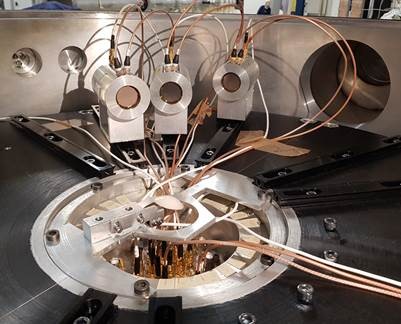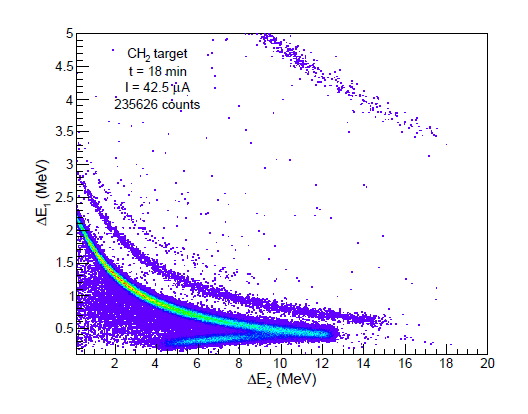- Homepage
- >
- Scientists
- >
- News & Highlights
- >
- 2020
- >
- December 2020: GANIL/SPIRAL2 Highlights
X. Ledoux (Ganil)
December 2020: GANIL/SPIRAL2 Highlights
New SPIRAL2 LINAC beam power output record.
Commissioning of the new superconducting linear accelerator (LINAC – Figure 1) continues apace at GANIL. This high-power accelerator will provide GANIL with new possibilities in terms of beams for nuclear physics research. By supplying beams at intensities up to 5 mA (3×1016 particles per second) the LINAC of the new SPIRAL2 facility (“Système de Production d’Ions Radioactifs en Ligne de 2nd génération”, 2nd generation On-line Radioactive Ion Production System) will enable GANIL’s various scientific and technical programmes to explore new frontiers.
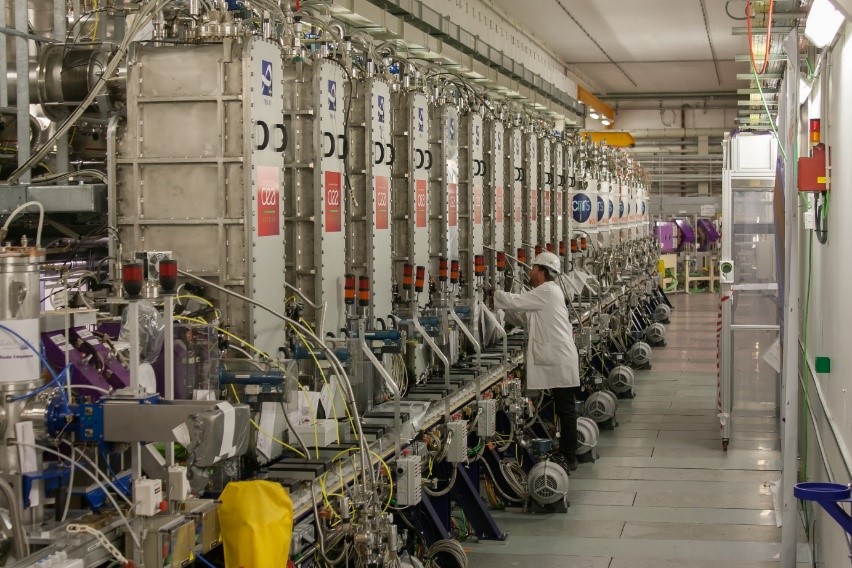
© P.Stroppa/CEA
A 16kW proton beam was delivered by the SPIRAL2 LINAC at the end of November 2020. This represents 10% of full power for protons and marks an important milestone for the project. Power has been increased gradually, according to the four-phase plan allowing to validate beam acceleration capability while ensuring optimum risk management (Figure 2). The first two phases were carried out in 2019 with very low intensity beams, allowing to avoid any damage due to eventual particle loss.
Since resumption of activity following the end of the first lockdown of 2020, huge efforts by all teams have been made in order to undertake the gradual stepping up of the beam current to reach its nominal peak intensity. Numerous machine studies have allowed to solve one by one the many different difficulties inherent to the operation of such a powerful device. On October 10th 2020 a 4.8mA beam was accelerated, representing the end of phase 3 of power increase in compliance with nuclear safety regulations. This demonstrated control of the full beam intensity.
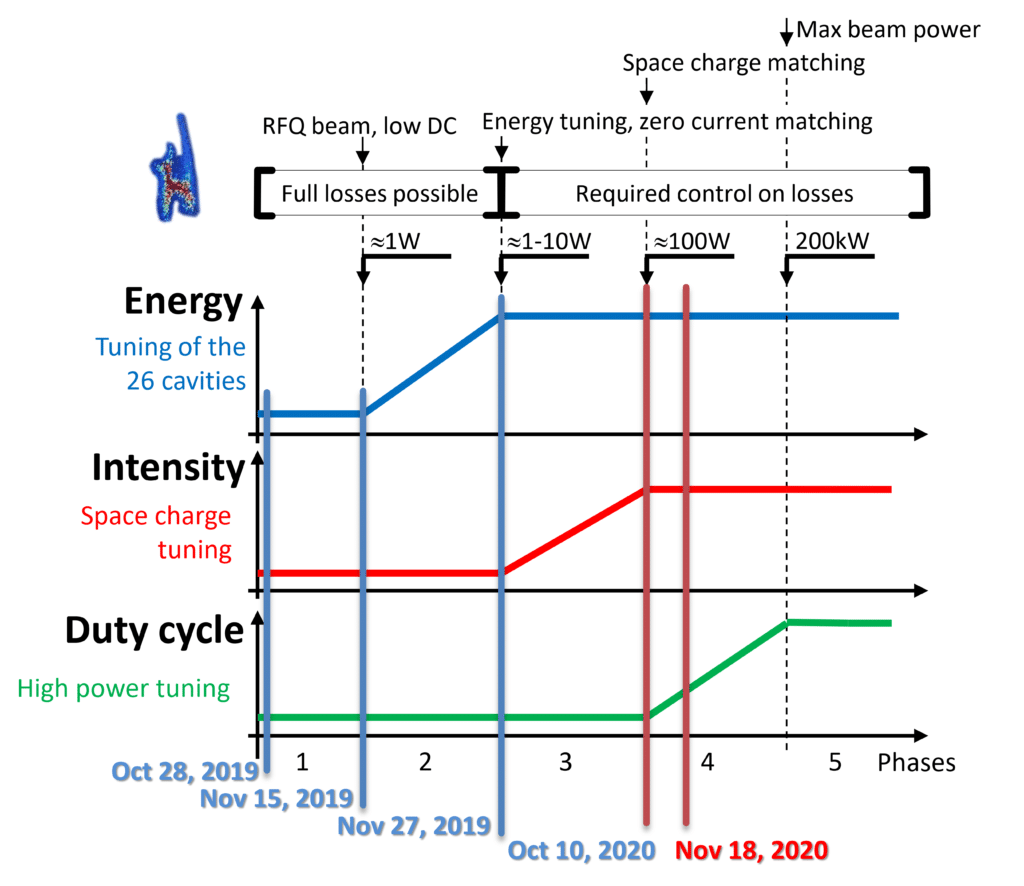
On 18th November a 16 kW beam was accelerated up to the main beam dump of the accelerator (Figure 3). This demonstrates control of extremely small beam losses, less than 10W for the whole machine. This loss control was made possible thanks to excellent understanding of the accelerator physics, resulting from many simulations and error calculations, by optimization of several cutting-edge techniques such as tuning the control system for RF wave injection, or the use of advanced functions such as the feedforward of the cavities.

This last milestone validates the excellent performance of the accelerator and allows us to serenely envision the final power increase up to the nominal 200 kW which will be obtained by accelerating a 5 mA beam of deuterium. Work towards this goal begins as of now with helium beam tuning in order to prepare the deuterium beams to be produced in 2021. LINAC beams will begin to be used for PAC approved experiments in autumn 2021.
Commissioning of the Neutrons For Science facility at GANIL
The NFS (Neutrons For Science) facility received the first proton beams produced by the new linear accelerator of SPIRAL2 at GANIL in December 2019. In parallel to the starting up of the accelerator in 2020, short periods of beam time were put to use testing successfully various elements of NFS. The first experiments at the facility are foreseen in autumn 2021.
A first 33MeV proton beam was delivered in December 2019 to the irradiation station of NFS (figure 1), which was coupled to a pneumatic transfer system allowing transport of the irradiated samples to a measuring station. The production cross-sections of several nuclei obtained by irradiation of iron and copper samples were thus measured. The results of the test are in agreement with previously published data. The irradiation and measurement apparatus, built and operated by physicists from the NPI laboratory in Rez (Czech Republic), will be used in future to perform unprecedented measurements of reaction cross-sections by activation.
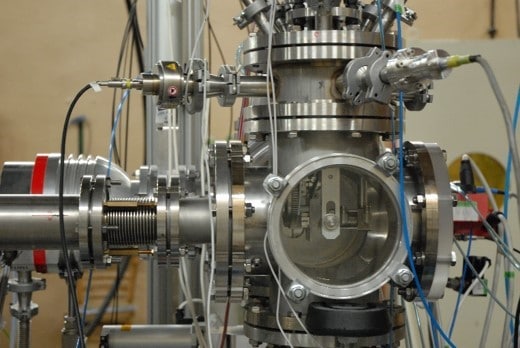
Interaction of a proton beam with thin targets (converters) made of lithium or beryllium was used to produce the first beams of quasi-mono energetic neutrons in September 2020. The energy spectrum and flux of neutrons produced at zero degrees were measured with a detector composed of a plastic scintillator coupled to a photomultiplier. The neutron energies were determined by the time-of-flight technique, i.e. by measuring the time taken for the neutrons to travel the distance between their production source and the detector. The time structure of the beam (width and frequency of neutron packets) allows to measure the neutron energies over the full range (1-30 MeV) with good accuracy. The spectrum of the neutrons produced by protons interacting with thin targets of lithium and beryllium is nearly mono-energetic, as shown in figure 2.
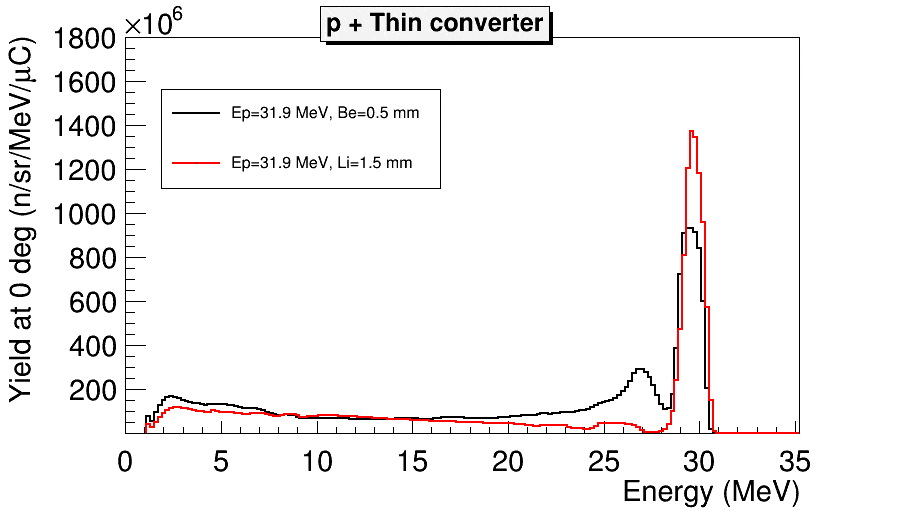
A thicker, rotating, beryllium converter, composed of an 8mm-thick disk 170mm in diameter, rotating at 2000rpm, was next to be tested. This converter was designed for 2kW power dissipation, corresponding to a 40MeV deuteron beam with a mean current of 50µA. This device developed by CEA Irfu is essential for future NFS experiments as it will allow to produce the most intense neutron fluxes. As the LINAC has not yet been commissioned for deuteron beams, a 31.9MeV proton beam was used. The neutron energy spectrum measured by the time-of-flight method is presented in figure 3. In this case, the energy spectrum is continuous. As shown in the figure, the measured spectrum is in very good agreement with previous data. Power dissipation tests were also performed, during which the evolution of the temperature in different parts of the converter was measured as a function of the dissipated beam power. A power of 1350W was reached and the measured temperatures are in agreement with simulated values.
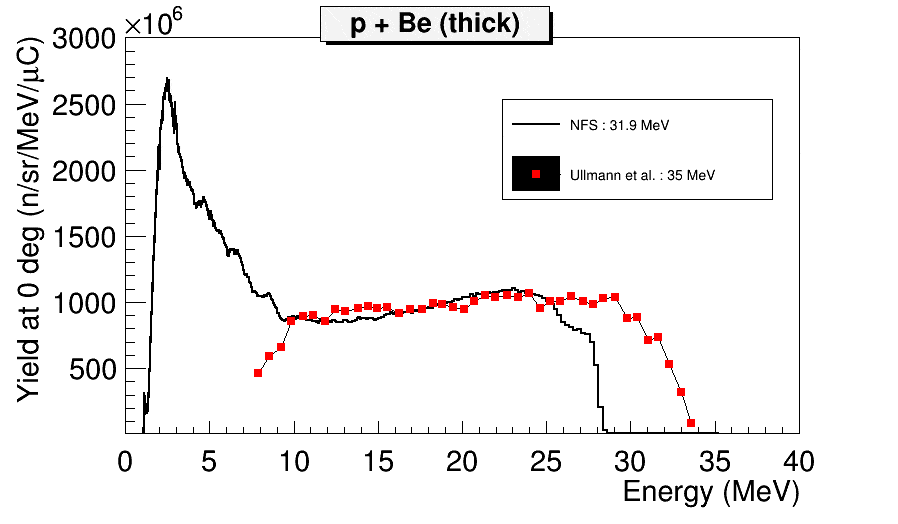
Last of all, during the autumn of 2020, a first test experiment was performed using the MEDLEY detector. This is composed of a reaction chamber containing several telescopes (Si-Si-CsI) which can detect light charged particles emitted by a target placed in the neutron beam. The signals generated by the detectors were treated by NUMEXO2 electronic modules developed at GANIL. Two targets, of CH2 and C, were used. Figure 4 shows an example of a spectrum produced using two detectors of a single telescope, allowing the identification of emitted light charged particles from their energy losses in the two detectors (∆E1-∆E2).

